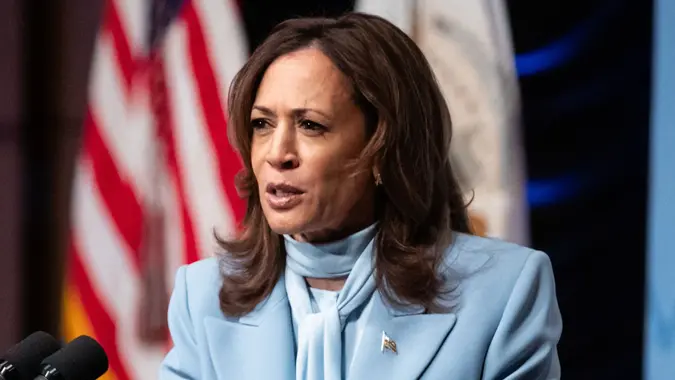Here’s What Kevin O’Leary Says a Harris Presidency Could Mean for Cryptocurrencies

Commitment to Our Readers
GOBankingRates' editorial team is committed to bringing you unbiased reviews and information. We use data-driven methodologies to evaluate financial products and services - our reviews and ratings are not influenced by advertisers. You can read more about our editorial guidelines and our products and services review methodology.

20 Years
Helping You Live Richer

Reviewed
by Experts

Trusted by
Millions of Readers
If the stock markets are any indication, cryptocurrency investors are nervous about the prospect of Vice President Kamala Harris winning the presidential election in November. As Reuters recently reported, U.S. crypto shares fell a day after the presidential debate, when Harris had a good showing against ex-President Donald Trump — the self-proclaimed pro-crypto candidate.
“Following the performance of Harris in the debate and perhaps Taylor Swift’s endorsement [of Harris], there is a slightly lower chance of a crypto-supporting Trump in the White House,” Susannah Streeter, head of money and markets at Hargreaves Lansdown, told Reuters.
But one interested onlooker who doesn’t seem too worried is “Shark Tank” investor and entrepreneur Kevin O’Leary. In a recent interview with the Decrypt website, O’Leary suggested that it doesn’t really matter who’s president when it comes to regulatory policy governing cryptocurrency.
“This is becoming bipartisan,” O’Leary said. “We’re going to have crypto policy, regardless of who goes into the White House.”
While O’Leary called Trump “pro crypto” following conversations with the Republican presidential candidate, Harris is more of an open book because she has not outlined specific plans for crypto regulation.
“She has no track record at all, which is probably in some ways a benefit for her,” O’Leary said. “She’s got a blank slate. She can start bringing policy in any way she wishes.”
Of the two major political parties, Democrats in general are seen as being more motivated to enact crypto policy. As Decrypt reported, Senate Majority Leader Chuck Schumer (D-New York) recently pledged to pass crypto regulation by the end of the year.
Some kind of regulation is “inevitable,” according to O’Leary, as lawmakers look to rein in an industry that has been rattled by volatility, SEC lawsuits against Coinbase and Binance, and the fraud conviction of FTX founder Sam Bankman-Fried.
Although Harris hasn’t revealed specific crypto policies, her team has reached out to billionaire Mark Cuban, another “Shark Tank” star, with questions about digital assets. O’Leary sees this as a “good sign,” Decrypt reported — partly because of hopes that Cuban will help ease the way to more transparency on crypto.
“I think the more they do with any resource to develop policies is very good,” O’Leary said. “But there’s a lot of policy on the Hill already.”
Editor’s note on election coverage: GOBankingRates is nonpartisan and strives to cover all aspects of the economy objectively and present balanced reports on politically focused finance stories. For more coverage on this topic, please check out What Crypto Regulations Could Look Like Under a 2025 Trump Presidency.
More From GOBankingRates
 Written by
Written by  Edited by
Edited by 




























